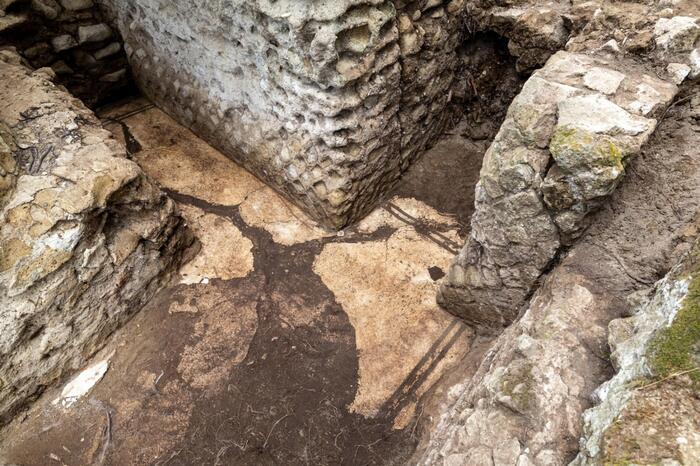A refined white mosaic carpet with a double black frame to delimit the living room overlooking the sea of Naples.
Disappeared two thousand years ago, when the fabulous residence passed into the hands of Augustus, a floor reappears in the Imperial Villa of Pausilypon that could finally tell something about its first owner, the rich and ferocious Campanian knight Publius Vedio Pollione,
successful wine merchant and politician, close to the emperor, who often honored him with his company, until he embarrassed him to the point of deserving, once dead, something very close to damnatio memoriae.
So much so that Augustus, heir to his possessions, occupied his homes, the beautiful house in Rome and the villa in Naples.
But he wanted to erase all traces of his first master, whose friendship, writes Tacitus, was also reproached many years later.
Listen to "Pollione's living room reappears in Posillipo, the uncomfortable friend of Augustus (by Silvia Lambertucci)" on Spreaker.
The news, after two millennia of history and at least two centuries of archaeological research, comes today from an excavation that the archaeologist Marco Giglio of the Oriental University of Naples
conducted with the concession of the Ministry of Culture and in agreement with the superintendence of archeology, fine arts and landscape of the municipality of Campania, engaged in a project to enhance the archaeological park of Posillipo.
While with Angela Bosco and Rosario Valentini they are working to develop a three-dimensional model of all the remains of this sector of the enormous villa.
"Ours is still a hypothesis", underlined to ANSA Giglio, who in this first excavation campaign, focused on the upper baths of the villa and then on a terrace that had been transformed into a military post during the Second World War, was was joined by his students.
Composed of tiny white tiles, the floor of what could have been Pollione's hall, he explains, was actually located under the baths presumably built by the emperor
and then several times restructured and modified.
Nineteenth-century researchers, led by a naturalist, had found it but perhaps they hadn't understood it, just as they hadn't been able to fully interpret the functions of the thermal environments and the service rooms that flanked them, including a praefurnium, or the oven in which the embers used to heat the calidarium burned.
"The new investigations have allowed us to understand that the room with the mosaic is older than the baths and belongs to a hall that overlooked the sea and was much larger than the room which was then occupied by the baths services", Lily says.
A stratigraphic dating is still missing, the archaeologist stated, but based on the style that hall could date back "to the late Republican age or Augustan at the latest".
Augustus reigned from 27 BC.
C., Pollione died twelve years after that date, in 15 BC, and it was then that his fabulous Neapolitan villa passed into the hands of the emperor.
However, for some time now, at least according to what Seneca and Cassio Dione tell us, he had distanced himself from a "friend" who had become uncomfortable precisely because of his exaggerated luxury, reprehensible behavior and immoderate cruelty.
Born into a family of former freedmen from Benevento, Pollione based his wealth on the production and trade of wine and owed his power to a series of prestigious political positions, in Asia Minor where he was proconsul, and then also as administrator of a imperial property in Egypt.
However, the man did not enjoy a good reputation: Cicero speaks very badly of him
("Numquam vidi hominem nequiorem", he wrote of him, that is: "I have never met a more iniquitous man") and an unpleasant episode is told due to a suitcase full of portraits of Roman matrons who had granted him their favours.
Above all, it is handed down of a dinner, right in Posillipo and with Augustus among his guests, in which to punish a slave guilty of breaking his glass, he had ordered him to be eaten alive by the giant moray eels of his fishpond.
Seneca and Cassius Dio write that the emperor intervened to stop him, saving the slave and ordering that all the precious glass in the house be broken and thrown into the pool.
But this was not enough for the emperor who then, having become the owner of those goods, decided to turn them inside out to make everyone forget who they belonged to.
The Roman house on the Esquiline, first of all, which he razed to the ground to replace it with a Portico dedicated to his Livia.
But also the grandiose villa by the sea, built in one of the most evocative places on the Neapolitan coast, with the rooms overlooking the island of Gaiola and the annexes that reached down to the beach, on one side the Cala dei Trentaremi, on the other that of the Lightning.
Augustus transformed it into a huge imperial complex, adding sumptuous buildings, arcades, gardens, even a public part with a
theater for 2,000 people
and another for reading poetry.
In place of the living room with a view in which Pollione entertained guests and showed off his possessions, he instead ordered to arrange the baths, or rather the service rooms for his personal spa.
Who knows, maybe once again to mark the distances.

